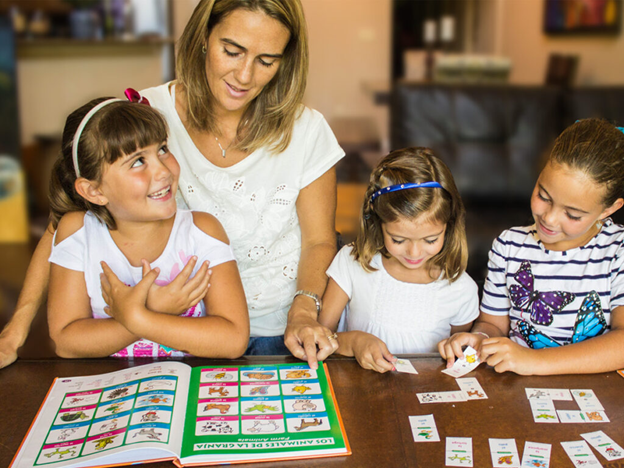Learning Spanish is one of the best gifts you can give your child. It’s a global language, spoken in many countries, and it opens up more doors in education, travel, and future jobs. Many companies and recruiters see Spanish as a huge plus, and it’s one of the easiest languages for English speakers to learn.
So, the real question isn’t why your kids should learn Spanish—it’s how to find the best Spanish curriculum for elementary and middle school students.
Choosing the right Spanish program matters a lot. The right curriculum shapes how your child learns the language and the culture that comes with it. It can also help keep your child excited about learning, stay current with global skills, and even save you money over time.
Let’s look at what really matters when picking the best Spanish program for your child—and how to make the best choice.
Choose a Curriculum That Builds All Four Language Skills
One of the most common problems I’ve seen as a Spanish teacher is that many Spanish curriculums focus only on speaking. While speaking is important, it’s just one part of learning a language. A strong Spanish program should also teach listening, reading, and writing.
When kids only learn to speak, they miss out on understanding grammar, reading stories, writing in Spanish, and hearing the language in everyday use. Speaking is important, but without support from the other three areas, progress can feel shallow or short-term.
A great Spanish curriculum—even one for preschoolers—includes a mix of:
- Speaking (having conversations)
- Listening (understanding spoken Spanish)
- Reading (reading books, signs, or instructions)
- Writing (making sentences, filling out worksheets)
This doesn’t mean your child has to spend hours learning grammar rules. It just means they should get a little of everything to grow stronger in the language step by step.
Match the Curriculum to Your Child’s Learning Style
Every child learns differently. Some are visual learners who love videos and images. Others enjoy reading or listening. Some kids do best with hands-on games, puzzles, and fun activities that keep their attention.
The best Spanish program isn’t just the one with the best reviews or flashiest website—it’s the one that fits your child’s learning style.
Ask yourself:
- Does my child learn best through pictures and videos?
- Do they enjoy reading?
- Do they need to move around and stay active while learning?
- Do they like using a computer or tablet?
- Are they more focused when someone teaches them one-on-one?
Once you know how your child learns best, it becomes easier to choose a curriculum that keeps them interested and helps them grow.
Look at how each curriculum plans to teach Spanish—not just what topics are covered, but how they are taught. A good program will include multiple teaching styles to reach different kinds of learners.
Pick a Curriculum That’s Flexible and Supportive
Flexibility is another key to success. A good Spanish program should offer a mix of tools like:
- Video lessons
- Worksheets and books
- Games and interactive activities
- Speaking practice
- One-on-one lessons or support when needed
A strong curriculum offers choices and makes it easy to adjust based on your child’s pace and progress. This is especially important if your child is learning from home or needs a schedule that fits around other classes or activities.
Also, support matters. Some programs only offer self-guided lessons with no teacher interaction. These may work for some, but many kids need help, feedback, or even just encouragement from a live teacher.
A one-on-one tutor or teacher can make a huge difference by giving personal attention, adjusting lessons to your child’s level, and helping them build confidence. From my own experience, this kind of support works much better than trying to teach a large group of kids all at once.
Make Sure the Level Fits Your Child
There are many Spanish programs out there, but not all of them are right for your child’s age or skill level.
A preschooler needs different lessons and activities than a high school student. Some curriculums are too basic, while others are too advanced. Picking the right level makes learning smoother and helps kids feel good about their progress.
Before choosing a program, think about:
- How old is your child?
- Have they studied Spanish before?
- Are they beginner, intermediate, or more advanced?
- Do they need something more playful, or something more serious?
A good Spanish curriculum will clearly state what age group and skill level it is made for. It should also offer ways to test your child’s level before starting.
Don’t Forget the Budget
Let’s be honest—cost matters. Spanish programs vary a lot in price. Some come with books, videos, or teacher access. Others charge per class or per level.
It’s easy to be impressed by fancy websites or big promises, but always ask yourself if the price fits your budget—and if the value is really there.
One smart way to compare is to look at the cost per class. This helps you see how much you’re really paying and if it’s worth it in the long run.
Learning Spanish takes time, so look for a program that gives steady value over the months or even years your child might be using it.
One Option to Consider: Homeschool Spanish Academy (HSA)
If you’re still looking for the right fit, you might want to check out Homeschool Spanish Academy (HSA). Their program is built around balanced learning—focusing on speaking, reading, writing, and listening.
They offer one-on-one lessons with certified native Spanish-speaking teachers from Guatemala, so kids get personal attention and real conversation practice. It’s flexible, meaning you can schedule classes around your family’s needs. And they offer programs for all ages—from preschool through high school.
The price per class is very competitive, and they’ve helped over 24,000 students so far. You can even try a free class to see if it works for your child before committing.
Final Thoughts
Helping your child learn Spanish is a smart move—and choosing the right program makes a big difference. Remember to look for a curriculum that:
- Develops all four language skills
- Matches your child’s learning style
- Offers support and flexibility
- Fits your child’s level and age
- Works within your budget
Once you find the right fit, you’ll see how quickly your child begins to enjoy and grow in the language. And you’ll be giving them a lifelong skill that can open doors around the world.
Ready to get started? Explore the options out there, and find the Spanish curriculum that works best for your child!










